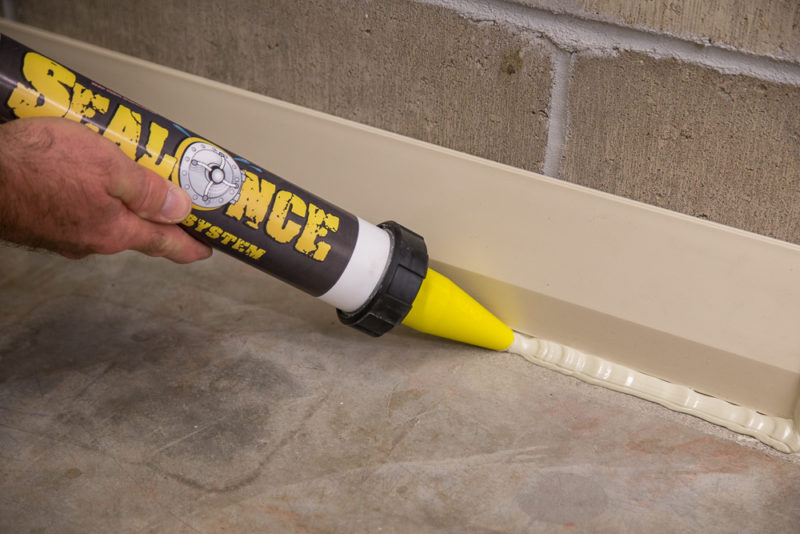Water in your basement is more than just an annoyance – it’s a sign of a bigger issue: hydrostatic pressure. When excess water builds up in the soil around your home’s foundation, it creates pressure that pushes moisture through cracks in basement walls, floors, and other weak points.
Understanding hydrostatic pressure and how to manage it is essential for keeping your basement dry and protecting the integrity of your foundation walls.
What is Hydrostatic Pressure in Detail?
When heavy rain, snowmelt, or a rising water table saturates the ground, excess water collects around your home. Because soil is porous, it absorbs moisture, creating pressure that pushes against your concrete foundation. If the pressure isn’t relieved, water infiltration occurs, forcing moisture through foundation cracks, the basement floor, and the cold joint where the wall meets the floor.
Why is Hydrostatic Pressure a Problem?
- Leads to Basement Water Issues – Water seeps through cracks, causing a wet basement, efflorescence, and mold growth.
- Weakens Foundation Walls – The constant pressure can cause foundation cracks, shifting, and bowing walls.
- Contributes to Basement Flooding – If water can’t drain properly, it pools on the basement level, leading to costly water damage.
Controlling hydrostatic pressure is critical for maintaining a dry basement environment and preventing long-term foundation problems.
Signs of Hydrostatic Pressure in Your Basement
If you notice any of the following issues, it may be a sign that water pressure is building around your home’s foundation.
- Basement water infiltration through cracks, damp or discolored spots on walls, or pooling water in low areas of the basement
- White, chalky residue on basement walls; an early indicator of moisture issues
- Vertical or horizontal cracks in the foundation or concrete
- Bowed or leaning foundation walls
- Musty odors, mold, and high humidity
Ignoring these warning signs can lead to basement flooding, costly foundation repairs, and long-term damage.

How to Relieve Hydrostatic Pressure
There are several proven solutions to reduce water pressure and prevent a flooded basement.
1. Drill Weep Holes in Block Walls and Install a Baseboard System
For homes with block wall foundations, trapped water inside the hollow cells creates hydrostatic pressure inside the walls. To relieve this pressure, small weep holes should be drilled into the bottom so water can drain into a drainage system.
Once the water pressure is released, a baseboard system like the SealOnce Basement System can be installed. This above-floor channeling system collects and redirects water toward the sump pump, preventing basement flooding. A baseboard style waterproofing system is ideal for monolithic foundations or when a minimally invasive solution is desired.
2. Install a Drain Tile System for Interior Waterproofing
A drain tile system is one of the most effective ways to manage excess water around a foundation. This system consists of a perforated pipe placed in a trench along the basement perimeter, allowing groundwater to drain into a sump pit, where a sump pump removes it from the home.
3. Use a French Drain for Exterior Drainage
A French drain is a type of exterior drainage system that moves excess water away from the concrete foundation before it can build up and cause hydrostatic pressure. It uses a perforated pipe buried in gravel that redirects groundwater before it builds up around your home.
This is a great preventative measure for keeping water out of a basement, but might not solve the issue entirely. In that case, an interior drain tile system should installed (as mentioned above in #2).
4. Install a Sump Pump and Sump Pit
A sump pump is an essential part of an interior drainage system. As basement water collects in a sump pit, the pump automatically removes it, preventing water damage and further flooding.
Consider a battery backup system to keep the pump running during power outages due to a storm or severe weather.
5. Seal Foundation Cracks
Foundation cracks should be sealed in poured concrete walls to prevent water infiltration and further structural damage. Encapsulating the basement walls with a poly moisture barrier will reduce the humidity levels in the basement and allow any water seeping from the face of the basement walls to travel down behind the poly liner and into your basement waterproofing channel.
Installing a poly vapor barrier on your basement walls is much easier and more effective than applying waterproofing paints or coatings, as those can bubble and peel away over time due to hydrostatic pressure.

Contact Waterproof.com
Ignoring hydrostatic pressure can lead to serious repair costs and ongoing water damage. If you’re dealing with water intrusion, now is the time to take action.
Why Waterproof?
- 50+ years of experience
- Industry-leading basement waterproofing solutions
- Products trusted by homeowners and contractors
Reach out to Waterproof.com to find the best basement waterproofing system for your home that will save you from costly, long-term damage.

